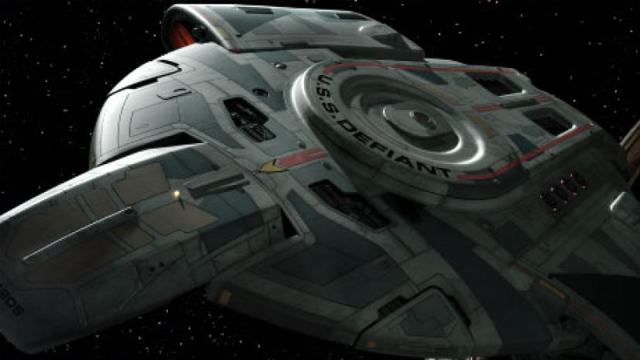Even at its most subversive, Star Trek still has to have a few certain kernels of established tropes to really feel like Star Trek — one of those being a ship for our captain and crew to boldly go in. Deep Space Nine, of course, naturally subverted both of these things, giving us a space station and a commander. But even when it could not resist, it still defied expectation with the Defiant.
On September 26, 1994, “The Search, Part 1” — the debut episode of Deep Space Nine’s third season — premiered, and brought with it many sea changes that would begin to see the show truly evolve into the dark, dramatic, and compellingly subversive series it is beloved as today.
It’s a fascinating turning point: The show had just introduced the alien, deadly threat of the Jem’Hadar, fanatical zealots from the Gamma Quadrant that the Federation couldn’t simply just talk their way out of dealing with.
In hindsight, we know it would bring about a conflict that would define the rest of Deep Space Nine’s existence, a grim conflict with the mysterious Dominion, a dark chapter that would interrogate and embolden the worth and meaning of the Federation’s deepest values. It would be war — a war that would test the very soul of everything Gene Roddenberry’s vision of Star Trek had held deep in its chest since the days of Kirk and Spock. And Deep Space Nine needed a ship to sail that sea at storm.
It got it in the U.S.S. Defiant.
The Defiant was unlike anything we’d seen on Star Trek before, from the perspective of the Federation. It’s almost, by intent, jarringly alien from what we come to think of when we imagine, up until that point, what a Federation ship could look like. It didn’t have the traditional, large disc-shaped bridge we’d expected of the franchise’s aesthetic, attached by a weirdly dainty (for a starship) neck to those glowing, tubular nacelles.
The Defiant was small, sleek, a nippy little thing a fraction of the size of either the original or Next Generation versions of the Enterprise. The smooth edges of those ships were still there in spots, but they were broken up by sharp, aggressive lines. If they were the space trucks of the Star Trek universe, the Defiant was the hot rod, and it packed the heat to match.
And that was the other thing that was distinctly new and alien about the Defiant. Star Trek and The Next Generation are series which defined themselves by the thesis that, in many ways, humanity had finally begun to outgrow its inherent barbarism and look to a utopian future.
Its iconic starships were reflective of that. These weren’t battlecruisers and frigates, attack fighters or almighty battlestations; the Enterprise in its myriad iterations was a ship designed for scientific research and exploration first and foremost. The Enterprise-D and its successors housed families and recreational services. That they are not designed with violent conflict in mind as a priority, but also considered the flagships of Starfleet’s navy, speaks to those evolved ideals.
Sure, we’d seen Romulan Warbirds, Klingon Birds of Prey, Borg Cubes — distinctly military vessels, weapons of war. And it’s not like Starfleet ships couldn’t defend themselves, either. Both Kirk and Picard had happily phasered and torpedo’d their ways out of a few dicey situations, and heck, the Enterprise-D specifically had a mode where it could jettison the civilian compartments of itself and turn into a giant, hilarious looking battle craft. But they stood behind the idea that when exploring a dangerous frontier, the best form of attack was often defence.
The Defiant was different: It was the first major Federation vessel we’d seen explicitly designed with war in mind. And in a society that had hoped to believe it had evolved so far beyond that, what did that even look like?
The answer, on a primal level, is incredibly cool.
With the Defiant — and a dash of CG technology, of course — Deep Space Nine could pull off space action unlike anything we’d seen on Star Trek before. “Sacrifice of Angels,” “What You Leave Behind,” “Dominion War,” “A Call to Arms,” the Defiant (and the refit that replaced it when it was destroyed in “The Changing Face of Evil”) led the charge in battles that were on a scale like no other. The cost? Perhaps learning that the Federation is very good at designing weapons of war when its back is against the wall is not as cool as it initially seems to be.
But that’s been a duality Starfleet and Star Trek has been struggling with, and attempting to interrogate, for practically its entire existence, from Captain Kirk to Michael Burnham. Is it a research organisation, or a military one? Are its members doctors and engineers, or are they commanders and officers with the rankings to match? What does it mean, paradoxically, that they and Starfleet at large are both?
In a version of the Star Trek galaxy at war, the Defiant became the literal embodiment of that battle for the franchise’s soul — the power to finish a fight so that better, brighter things could rise from its ashes.
On the surface, it might look unlike anything we’ve seen from the franchise’s main ships-of-the-line before or since it, but the Defiant is much closer to the heart of some of Star Trek’s oldest values than you might have thought.
